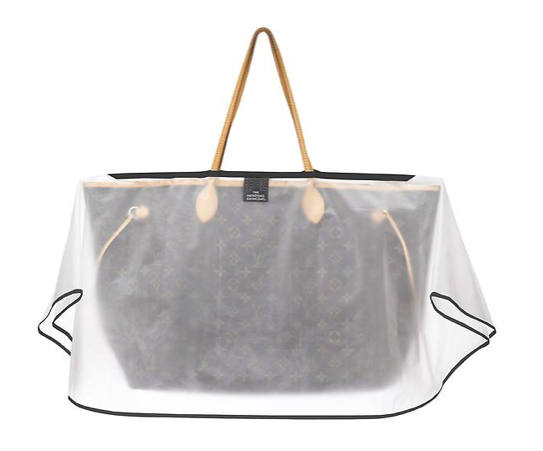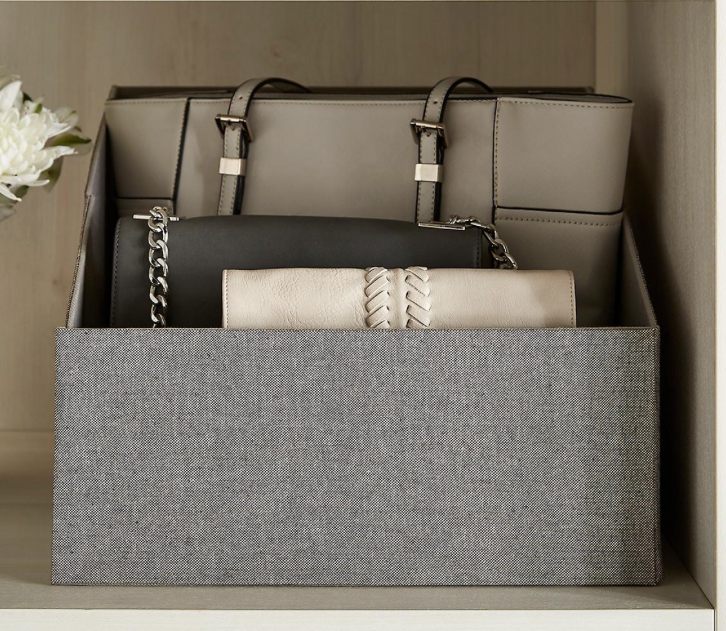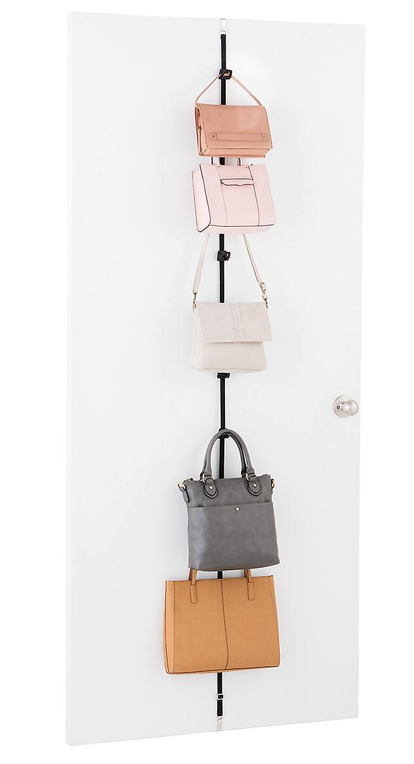Whether you carry a clutch or a messenger bag, a wristlet or a satchel, a cross-body or an evening bag, you know you need to keep your purses, handbags, and totes orderly. Otherwise, they’ll get dusty, lose shape, and lose their status. With a few simple strategies, however, you can keep your purses organized and ready for anything.
USE PROTECTION
You carry a handbag to keep your possessions neat and tidy and to protect them from the elements, but how do you protect your handbag? There’s only so much you can do to protect your bag when it (and you) are in the wild, but here are some keys to avoiding the main natural predators of your handbag when it’s hibernating:
Dust (and Insects) – Use the “dust bags” or purse covers that come with your purse (or buy inexpensive after-market dust bags), a dye-free pillowcase, or soft T-shirt, or lidded containers. Some possible alternatives:
Tinton Life (set of 10) drawstring dust covers
Container Store’s Handbag Raincoat

Mia Cotone fashionable dust covers
Bridawn Clear Dustproof Handbag Protector
Moisture/Light/Heat – Don’t store purses in moist or damp areas of your home (like laundry rooms or basements). Store purses away from heat or air conditioning vents and away from sunbeams through skylights and windows. “Cool, dry, and dark” is the best neighborhood for purses. Use desiccant packets inside bags and in any storage area.
Pets and Children – Keep purses on shelves higher than the reach of furry friends and tiny humans.
Losing Shape – Store bags upright, and don’t pile or stack purses on top of one another or the weight of one bag may damage those below. Stuff purses with acid-free paper (which can be purchased inexpensively at art/craft stores), ink-free tissue paper (so the purse’s lining doesn’t get stained), or handbag shapers help keep them in good form.
 Scuffs – Keep bags separated to ensure that any “hardware” (chains, zippers, buttons, etc.) on one bag doesn’t scuff or mar an adjacent bag. Patent leather is especially delicate and should be protected with a soft purse cover or acid-free tissue paper.
Scuffs – Keep bags separated to ensure that any “hardware” (chains, zippers, buttons, etc.) on one bag doesn’t scuff or mar an adjacent bag. Patent leather is especially delicate and should be protected with a soft purse cover or acid-free tissue paper.
ORGANIZE FOR VISIBILITY AND EASE OF ACCESS
Organize purses according to what makes logical sense to you. Options include by color, by season, or by size. If you opt for seasonal organizing (brighter colors for Spring/Summer, more muted or darker colors for Fall/Winter), keep the current season most easily reachable.
Group special occasion bags – evening bags, holiday-themed purses, vacation totes, etc. – together and less accessible, since you’ll need them less often.
STORAGE OPTIONS
Easy Access: If you store purses in their dust covers, label the shelf edge with the purse description. If you use the original box, “label” with a description or photo of the purse. The faster you find your purse, the sooner you can be out on the town.
On Shelves – Protect against splinters in wooden shelves and ridges/indentations from plastic-coated wire shelving. Cover the surface of the shelves with a dye-free soft towel or an attractive shelf liner. Consider a stiff shelf liner over wired shelving to protect soft leather from ridged imprints.
- Shelf dividers – Keep bags upright with the help of acrylic or wire shelf dividers.
- Modular Shelving – Check the dimensions of your purses before investing in modular shelving to ensure you don’t squish your bags. Standard pressboard cubes lack the variation and adjustability you need to accommodate all sizes of handbags, clutches, totes, etc., so consider customizable modular shelving.
- Purse storage boxes (cloth-covered) – Boxes will keep handbags self-contained and from falling off the shelf, but many are open-top, so dust can be a concern. Cover lidless boxes with a soft, dye-free T-shirt for dust protection. Some box options:
Container Store Purse Storage Bins in Grey

Mainstays Natural Canvas Storage Box with Window
- Bins/flat-bottomed baskets/cubbies (with or without cubes) – Aim for dye-free materials without rough edges or ridged surfaces to protect delicate leather, cloth, and stitching.
Vertical handbag options – When shelves aren’t an option and horizontal storage space is at a premium, consider trying to be on the up-and-up with your purses. Consider these options:
- On back of a door — smaller purses like clutches and evening bags can fit nicely on the reverse of the closet door in hanging shoe bags. There are also mountable racks, suitable for your closet door or wall, for keeping purses aloft.

A note about hanging storage: You CAN store shoulder bags by hanging from the straps, but over time, it will add wear & tear to the bag. You may see DIY advice on the internet recommending hanging your bags from shower curtain hooks, but the narrow metal loops can damage even the thickest, sturdiest straps. If you must hang your bags, opt for a solution that provides good support from materials, like acrylic purse hangers.
BEFORE YOU STORE
Clean out your purse before you store it. Remove makeup, pens, receipts, candy, or any other junk inside. A small packet of tissues, a few “emergency” dollars, and a stack of business cards are the most you should keep in your bag on an ongoing basis when it’s not in daily or weekly rotation.
If you switch among medium-to-large handbags often, use a multi-pocket removable purse organizer insert to keep the interior of your bag organized. Just move the whole kit & caboodle from purse to purse. A few options include:
InBag Purse Organizer (for large purses)
ZTUGO Purse Organizer Insert
Vercord Purse Organizer
Whatever kinds of purses, handbags, or totes you carry, keep them organized inside and out, and they’ll keep you organized, too. You’ve got this. It’s in the bag!


 Scuffs – Keep bags separated to ensure that any “hardware” (chains, zippers, buttons, etc.) on one bag doesn’t scuff or mar an adjacent bag. Patent leather is especially delicate and should be protected with a soft purse cover or acid-free tissue paper.
Scuffs – Keep bags separated to ensure that any “hardware” (chains, zippers, buttons, etc.) on one bag doesn’t scuff or mar an adjacent bag. Patent leather is especially delicate and should be protected with a soft purse cover or acid-free tissue paper. 





Follow Me